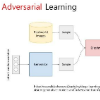Existing domain adaptation methods tend to treat every domain equally and align them all perfectly. Such uniform alignment ignores topological structures among different domains; therefore it may be beneficial for nearby domains, but not necessarily for distant domains. In this work, we relax such uniform alignment by using a domain graph to encode domain adjacency, e.g., a graph of states in the US with each state as a domain and each edge indicating adjacency, thereby allowing domains to align flexibly based on the graph structure. We generalize the existing adversarial learning framework with a novel graph discriminator using encoding-conditioned graph embeddings. Theoretical analysis shows that at equilibrium, our method recovers classic domain adaptation when the graph is a clique, and achieves non-trivial alignment for other types of graphs. Empirical results show that our approach successfully generalizes uniform alignment, naturally incorporates domain information represented by graphs, and improves upon existing domain adaptation methods on both synthetic and real-world datasets. Code will soon be available at https://github.com/Wang-ML-Lab/GRDA.
翻译:现有的域适应方法倾向于平等地对待每个域,并完全调整所有域。 这样的统一调整忽略了不同域之间的地形结构; 因此, 它可能有利于附近域, 但也不一定有利于远域 。 在这项工作中, 我们放松了这种统一的调整, 使用一个域图来编码域的相邻性, 例如, 使用一个美国各州的图表, 以每个州为域, 显示相邻性, 使各个域能够根据图形结构灵活地调整。 我们用一个新颖的图形区分器将现有的对抗性学习框架概括为使用编码化的图形嵌入器。 理论分析显示, 在平衡时, 当图形是圆形时, 我们的方法会恢复典型域的适应, 并实现其他类型图形的非三角对齐。 经验性结果显示, 我们的方法成功地将统一一致的一致化, 自然整合了以图表代表的域信息, 并改进了合成和真实世界数据集的现有域适应方法。 代码不久将在 https://github. com/ Wang- MLab/ GRDADA 上公布 。



